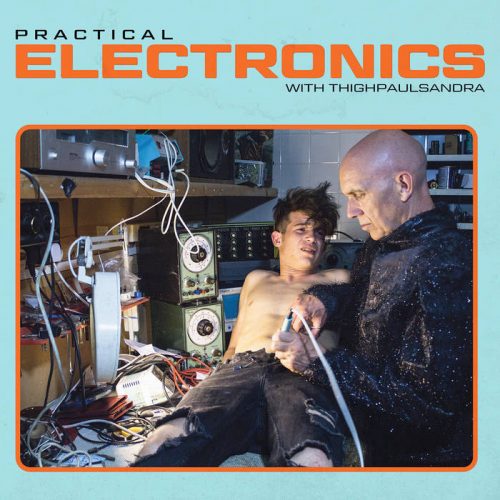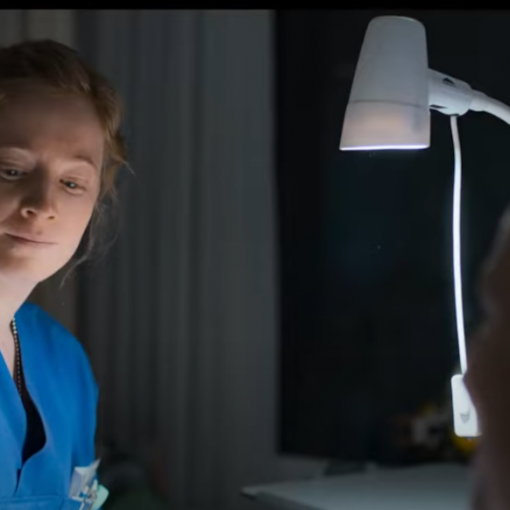Portland, OR
9 May 2014
A burly dude writhing on the oscillators wearing a plastic Viking helmet is pretty much what you hope to greet you on stage when attending a psych rock gig.
Portland’s best and beardiest turned out to the barn cathedral interior of Mississippi Studios for a killer psych double-header: Osaka, Japan’s legendary Acid Mothers Temple (and the Melting Paraiso U.F.O., for the occasion), along with Bostonian math-rock eccentrics Perhaps, who were creating the helmeted sludge metal spectacle when I entered the room.
I have been going to Acid Mothers’ gigs for years now, and am always blasted by the spectacle, but there is a special feeling of seeing psych rock on the American West Coast. Where other places, like Chicago, it might seem a bit of a curiosity, a novel throwback, on the West Coast it doesn’t seem like psych has gone anywhere – like it always has been and always will be. It’s easy to imagine the ghost of Jefferson Airplane‘s boots climbing wooden staircases beneath liquid psychedelic light shows. On top of this, Portland’s misty demeanour and the fact that it occupies a similar latitude to Japan makes AMT’s electrified chthonic worship all that much more appropriate.I came into the latter half of Perhaps’ set. I was expecting notorious Seattle space rockers Kinski to be opening, as I believe they were on the bill originally and I love taking a ride in their saucer, but I tried not to hold the change in billing against the ambiguously titled Bostonians. AMT are known for having killer openers, and Perhaps were no exception.
This five-piece of guitar, bass, drums and TWO synths plowed through about 18 genres in the 15 minutes of their set that I caught. Perhaps have cited progressive rock, free jazz and classical music as influences, and tore through all of them with a level of Mike Patton-like ultraviolence, with more tempo changes and time shifts than a transmission choking on it’s own parts, but stitched together seamlessly. A Max Ernst collage of the last 50 years of art rock. This level of bricolage runs the danger of becoming cartoonish or satirical, which Perhaps overcame with earnestness. They went for it, playing their heart and soul out; spilling their guts. Like a 12-step programme, psych rock works when you work it.Perhaps embody what I love about psychedelic music – it’s not about image or hip posturing. It has always been a haven for weirdoes and SF fanatics. Far-out 60s-ness will always persevere, and there will always be a place for it. I definitely plan on checking out Perhaps’ much-touted début, Volume One, and you’re recommended to do the same.
There is a much-circulated colloquialism among rock writers that in Japan, Blue Cheer were bigger than The Beatles. It sounds like a pat and cutesy soundbyte that is easily circulated, but for 1.) it sounds like this is actually true, as the Japanese government were heavily down on The Beatles, nearly declaring martial law when the quartet played in Japan in 1966, and 2.) imagine the implications, the alternate history, if you will, if volume, repetition, attitude and menace were valued over the prog-art classicism that rock ‘n roll evolved into in the wake of Sgt. Peppers‘ and Pet Sounds.
Guitarist and head wizard Kawabata Makoto started Acid Mothers Temple out of an attempt to fuse “hard rock like Deep Purple with the electronic music of Stockhausen,” according to an interview for Pitchfork, as well as to transform a ringing sound Kawabata heard in his ears into structured pieces, and to recreate a heavenly choir he heard in his dreams. This unique blend of hard rock minimalism and personal cosmology has yielded one of the most lush, diverse and strange discographies in the history of psychedelia in the 19 years since AMT’s inception.Consider the fact that Acid Mothers Temple formed in 1995, you will realize what an anomaly they are, and how much water has passed under the bridge since the late ’90s. In the mainstream culture, at least, psychedelia couldn’t have been farther from cool, which was mainly being overrun by dark, edgy, gothic sounds like Nine Inch Nails and Marilyn Manson, as well as the sounds of rave coming above ground, the beginning of big room, festival electronic music. [Please keep in mind this is just my perception of what it was like in Chicago, where I come from. I have no idea what popular culture was like in other places in ’95.] The archival raiding reissue mania had not yet begun, and basically, anything old was pretty well lame.
Because of this, it was heart-warming to see a packed room on a Friday out to see one of Japan’s grizzliest exports. There was a wider diversity in the crowd than normal, ranging from grey-haired ladies to sandalled gentlemen, who seemed like they used to go see LaMonte Young when he toured, to the prototypical Portland intellectual metalhead. There was drinking, dancing, and even headbanging. There was even a gentleman in a Pearl Jam hoodie who was shocked “by how loud it was. My wife is never going to believe that I stayed,” who kept edging closer to the stacks. That statement alone let me know here was a noob to the Acid Mothers’ mothership, as the volume was pretty tame by Acid Mothers standards, downright listenable, I would say, as some of their gigs I’ve seen in the past have been some of the loudest live spectacles I’ve ever seen, similar to standing in a wind tunnel being blasted with cheese graters. And nuclear sand.Most of Acid Mothers Temple songs follow a similar template: start off with a simple, repetitive riff, maybe five or six notes, possibly doubled by the guitars or the bass, which then builds and builds until it becomes a howling nuclear tornado and Kawabata unleashes the dark matter of the universe through flying fingers on the fretboard. Their set was comprised of four lengthy jams each upwards of 10 minutes that amazed with waves of energy undulating off of the stage. It’s hard to know the names of all of AMT’s songs, as they have more records than the Latter Day Saints’ genealogy library, and not many of them have words or singing in English, but I did manage to detect the presence of “Chinese Flying Saucer” and the live favourite “Pink Lady Lemonade,” which was transcendent.
Acid Mothers, especially live, occupy three main territories: traditional psych/space rock, a la Pink Floyd; proto-biker/sludge/stoner/metal, a la Hawkwind or Black Sabbath; and what has been called space folk, a mixture of Occitan and traditional Japanese folk music, with added throat singing. Usually, in the past, a performance seemed to take preference over one or the other, but this evening’s show was an even split between all three, with a stronger presence of sludgy intergalactic biker grooves and space-age psychedelia; which is a good thing, as I love it when AMT rocks!
[pullbass id=”space”]It wasn’t until the day of the show that I noticed what a major contribution to the band that Higashi Hiroshi‘s synthesizer, and the tectonic grind of Tsuyama Atsushi‘s bass. There’s a lot of people out there, especially now, who are exceptionally good at intricate and technically proficient stoner grooves – there’s a lot of head music these days. But the presence of Hiroshi’s atonal synth ululations gives AMT’s music a decidedly sci-fi flair, like the soundtrack for Fantastic Planet on top of Orange Goblin, which makes for much more interesting and diverse mental movies. Atsushi’s bass lays the groundwork, giving that necessary propulsive bottom end that holds the whole thing together, that hits you in the gut as well as the head.
All of this provides the launch pad for Kawabata to enter orbit, usually about 2/3 of the way through a song. In interviews, he has spoken of being a conduit for the cosmos, and he has truly become a pure vessel of deep space and neutron waves, expressed with wild abandon and flying mane (which has not grayed in the slightest in the 12 years I’ve been seeing AMT live).
Suddenly, i was struck by the dismissive “just another psych gig” or “Acid Mothers are coming back to town!” with the response “O yeah, aren’t they here all the time?” Yes. That should tell you something. Everyone involved in Acid Mothers Temple are trve black magick intergalactic road warriors, tirelessly plying trvth and vibes across the spheres. I was reminded of Dean Benedetti, a saxophonist who used to follow Charlie Parker around and record him, even going so far as to record from the bathroom or through a hole drilled in the bandstand. Will anyone be going to this length, to preserve and comment on Kawabata’s legacy? Just because it’s got phase, flange and echo on it doesn’t mean “it’s only rock ‘n roll” or “just another psych gig,” and just because you’ve seen Acid Mothers once does NOT mean you have seen it all.Indeed, on this occasion I was struck by how much Acid Mothers Temple live were like a free jazz ensemble, with many moments reminding me of Sun Ra. Ra used to have his musicians play something called a fireball, where every musician played a screaming note at once, replacing music with tone and texture. Acid Mothers are particularly adept at creating this whiplash cyclone of energy, which, when it breaks free, eradicates all thought, irons the wrinkles in yr brain, leaving you with a calm cerulean sky pond in yr mind.
I was also struck by how I’d experienced similar epiphanies from many different traditions, standing in the exact spot where I was standing, from the apocalyptic tango of Thee Silver Mt. Zion to the rushing futurism of Trans Am; to transgender fairy tales, courtesy of Baby Dee; and I realized how connected we all are, how far we’ve come, and how much there is to know, to attempt to write about all of this as a music journalist.I also highly recommend you check out AMT’s newest, Astrogasm From The Inner Space, which was released as a double LP on Important Records for this tour.
-J Simpson-



